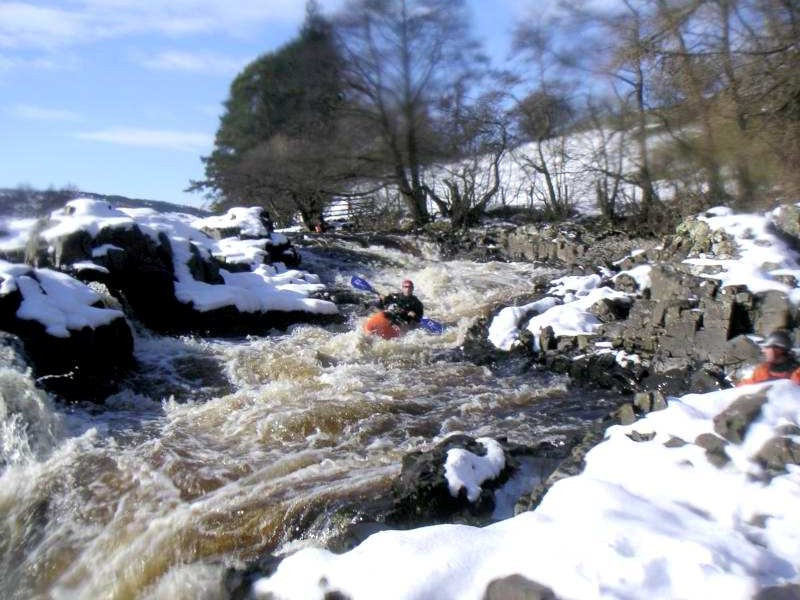Personal Equipment for Winter Trips

Winter provides paddling opportunities
which don't arise in the summer. This is
because there is often more water in the
rivers, and many whitewater rivers are forbidden to
us except during the mid-winter spawning season.
When taking part in day or weekend trips in the
British winter the biggest risk is likely to be of
hypothermia. This is dangerous for the individual,
and also puts the rest of the group at increased risk,
because the delay increases the chances of other
members of the group succumbing to the cold.
Clothing
The clothing usually used consists of a windproof
and water-proof outer shell, protecting
multiple layers of insulating clothing.
The outer layer could be a drysuit, a dry-top and
waterproof trousers, or at the very least a semi-dry
cag and waterproof trousers. The possibility of a
swim early in the trip must be borne in mind, so
keeping the insulating layers dry is important.
The insulating layers are usually thermals, although
wetsuits can be used as well. With a wetsuit, at least
one long-sleeved top is necessary (most wetsuitts are
sleeveless), and some more layers are advised.
Thermal trousers are recommended, with wetsuit
shorts if a wetsuit is not worn.
Footwear will usually include wetsuit boots, with
socks inside. The outer footwear needs a reasonable
sole, to protect the feet when on the bank, or when
climbing out after a swim.
A woolly hat or paddling skullcap worn inside the
helmet prevents a significant degree of heat loss.
Hypothermia is a particular risk because of the
combination of wind with cold, often wet, weather,
and contact with water. A typical trip will involve 4
to 5 hours time spent paddling or on the river bank,
so it is vital that paddlers are correctly equipped to
stand up to the conditions. It is not unknown for
temperatures of -2C to be encountered during
paddling days, sometimes with a breeze as well. The
coldest part of many trips is the lunch stop, when you
are out of the windproof boat.
Hands will get cold. There is no ideal solution, but
possibilities include gloves (cycling, windsurfing,
jetski types can all be used), palmless mittens made
for paddling, or pogies, a windproof loose glove
which attaches to the paddle. You will need to
experiment in advance of any trips to find out what
works for you.
On a weekend trip you should plan for all this kit to
get wet on the first day. Many of the bunkhouses we
use have poor to non-existent drying facilities, so
spare inner layers for the second day should be
considered. It is not just for comfort when getting
dressed - putting cold, wet thermals on starts the day
cold, and it is difficult to warm up before paddling.
Don't forget at least one towel.
Don't be fooled by your playboating experience paddling
for an hour then going into a warm
changing room for a shower is very different from
spending the day on or near water, then changing on
the riverbank.
And Also...
In addition to clothing you will need a boat,
paddle, buoyancy aid, spraydeck and helmet. If
you need to borrow any of these from the club,
you need to contact the equipment officer (phone
number on Breakout) well before the trip to book the
kit, and arrange when you will collect and return it.
You will also need lunch, and on most trips, a way to
carry it in the boat while keeping it dry. Lunch should
be a snack - we normally manage to arrange a full
breakfast from a nearby pub, along with substantial
evening meals. Pre-packed sandwiches from
motorway service areas are surprisingly good for this,
and have a packet which helps keep water out. Zip-up
plastic bags are useful, and a proper kayaking dry-
bag is a good investment. You may be able to borrow
one of these until you have your own. You will need
a drink, as you can dehydrate even in cold weather,
and a hot drink is recommended.Finally you need to
make sure that you still fit into the boat when wearing
the extra clothing. It may well be necessary to adjust
the footrest or backrest, or even the seat position. It is
not a good idea to be doing this on the riverbank
while the rest of the group get cold. Make sure your
helmet fits over your hat.
Checklist
- Cag/drysuit
- Waterproof trousers
- Thermals, tops and trousers
- Shorts
- Boots
- Socks
- Gloves/pogies
- Skullcap/hat
- Towel
- Lunch
- Lunch bag
- Boat
- Paddle
- Buoyancy Aid
- Spraydeck
- Helmet
Do you still fit your boat?
Will your helmet go over your hat?
